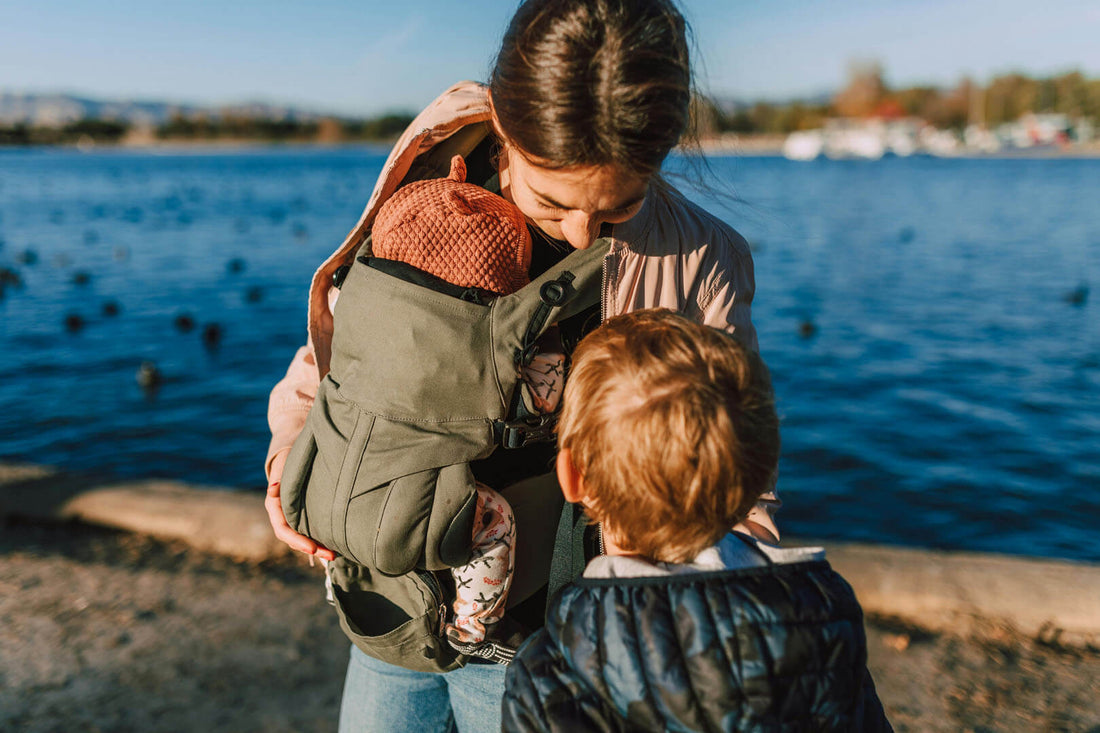
When Can a Baby Face Forward in Carrier? (How to Know)
Using a baby carrier is an easy way to do so while being hands-free.
When babies mature, you’ll eventually be concerned about when it is safe for them to face forward in a carrier.
Forward-facing carriers can give your little one a fresh view of the world.
However, it is important to know when and how this transition time fits so that they remain safe and comfortable.
This extensive guide will provide you with all the information about when a baby can face forward in their career.
Additionally, it will provide relevant topics to help you make an intricate decision.
Portable Diaper Changing Station
Before explaining the ins and outs of front-facing baby carriers, we’ll also start using a backup diaper changing station.
If you are traveling with a baby, you must be ready to change the diapers whenever needed.
A portable diaper change station is great for parents with an active lifestyle.
These stations usually have a foldable water-resistant changing pad, compartments for diapers, wipes and diaper cream.
Sometimes, even other pockets hold additional baby accessories.
The portable diaper changing station ensures you can change your baby anywhere.
At the park, at the airport or at a friend's house.
It just gets done fast and clean!
Can a 3 Month Old Face Forward in a Carrier?

It may be tempting to turn your baby forward when they start noting the world around them.
However, you need to consider their physical development.
Before using a forward-facing carrier position, most experts recommend waiting until a baby turns 4 to 6 months old.
A baby's neck muscles and spine are not strong enough to hold head weight in their head.
Their upper bodies also aren’t strong when putting their face down until they have reached three months of age.
Babies at this age still have poor neck muscle strength and limited head movements.
When babies are too young, making them sit on their own in a forward-facing carrier can end up straining the neck and spine.
This will eventually cause discomfort or injury.
So, keeping this activity for later when your baby has more head and neck control is recommended.
How Will I Know When Baby is Ready for a Forward Facing Carry?
Watch their body development and signs to find out when your kid is ready for forward-facing carry.
Some of the posts below how you might be able to tell your baby is ready:
Good Head and Neck Control
One of the major clues is if your baby can hold his/her head up on its own without support.
It generally happens at the age of 4/6 months.
Infants must have good neck muscles to hold their heads for over a second or two.
Interest in the Environment
When your baby becomes more curious about what is around them and wants freedom of sight, he might be okay with turning his head when facing the carrier.
Weight and Size
All the major providers have a 20-pound minimum weight limit for forward carriers.
Ensure your baby falls within the weight limit for each carrier, generally between 13 and 20 pounds (6 and 9 kg).
Age
While it is not just age, many babies are developmentally old enough for forward-facing carries between 4 and 6 months.
Talk to your pediatrician if you are unsure when it is time for your baby.
When Can You Face a Baby Forward in a Car Seat?

Just like carriers, properly timing the forward-facing direction for your baby in a car seat is very important.
Pediatricians have recommended long-lasting rear-facing car seat use, typically until age 2.
But ideally to the highest height and weight limits on their particular child passenger safety seat.
Rear-facing car seats provide more upper body control for an infant in a crash.
Transitioning to a forward-facing car seat at the wrong time can increase the likelihood of serious harm in an accident.
Rearward-facing car seats are made to spread the impact forces more equally, shielding your baby's delicate neck and back.
So, the best thing is to adhere to the guidelines.
Keep your baby rear-facing for as long as she can until that car seat ‘s weight limit.
Forward-Facing Carrier
Is forward facing carrier bad for baby?
This is a question that many parents ask about.
It is still unclear whether forward-facing carriers are bad for babies.
Most of the questions concern hips or overstimulation.
Hip Development
According to some experts, one concern is that the baby's hips may not be as well-supported when in the forward-facing position.
In a front-facing carrier, a baby's legs dangling may not be good for hip development, particularly in younger infants.
To counteract this, opt for a carrier that supports your baby's hips well and keeps their legs in more of an "M" shape, with the knees higher than the bum.
Overstimulation
Babies positioned to face forward can be exposed to more stimuli than they want and may become overstimulated.
Look out for cues of overstimulation, such as irritability, crying, or turning away from the surroundings.
Switch back to inward-facing if your baby appears overburdened.
Comfort and Safety
Experience the forward-facing position by ensuring that your baby is comfortable and secure.
Make sure that the airway is clear and that the baby is not collapsing or leaning forward in a way that may obstruct its breathing.
What Outward-Facing Carriers Work Best for Babies?

When you select a carrier, make sure that it has this position to face forward similarly to a baby facing toward your chest, and look for models made particularly for this purpose.
So some of the features should be as:
- Ergonomic Design
Opt for a carrier that effectively supports your baby's hips and legs as well, ensuring they are in an ergonomic posture similar to the "M" position with knees above their hips.
- Adjustable Settings
A properly adjustable fit helps the carriers grow with your baby, providing better support as they develop. The best carriers have a variety of adjustable straps, seat widths, and height settings.
- Padded Straps and Waistbands
Comfort from the parent is also crucial. Padded shoulder straps and waistbands help cushion your baby's weight, ensuring it is distributed more evenly to prevent straining of the back and shoulders.
- Breathable Materials
Let you and the baby relax in the summertime with breathable baby carrier components for refreshing airflow.
- Safety Certifications
Ensure the carrier is safety certified and has great parent ratings.
It can be frightening and we know what it feels like to read that certain products, even those from reputable brands have been tested safe for babies.
Transitioning Young Children from Inward Facing to Forward Facing in a Carrier

Moving a baby from an inward-facing to a forward-facing position will have to progress slowly initially, and comfort and safety should be placed first.
How to smoothly transition:
Start Slowly
Start by carrying your baby forward for about 10-15 minutes, and build from there as they get used to the different positions.
Watch for Cues
Observe your baby's reactions.
If they are uncomfortable, fussy, or overwhelmed, return them to inward-facing and try again later.
Comfort Check
Keep your baby safe and relaxed in a forward-facing position.
Adjust the baby carrier as needed to support the baby's hips and spine.
Gradual Exposure
Introduce the forward-facing position during calm, less stimulating times.
It can help your baby acclimate without becoming overstimulated.
Engage and Interact
Engage with your baby while they are facing forward.
Talk to them, point out interesting sights, and maintain a reassuring presence to help them feel secure.
Alternate Positions
Continue to alternate between inward and forward-facing positions, depending on your baby's mood and the situation.
Flexibility can help your baby adjust more comfortably.
Conclusion
Understanding the right time to face the baby forward in the carrier provides safety and comfort for your child.
Most babies are developmentally able to safely ride forward-facing by around 4-6 months.
They begin doing so as soon as their neck control is good.
By selecting the correct carrier, supporting your ergonomics, and ensuring a smooth transition, you can transform babywearing into a happy experience for both them and yourself.
Ensure you check for signs and follow the regulations.
Ask your pediatrician if you need to know when it is a good time to forward.
Correctly following these tips can help you have many happy adventures with your baby in the carrier.
FAQs
1. Can a 3-month-old face forward in a carrier?
Experts suggest using the forward-facing carrier only once your baby turns 4-6 months old.
A baby cannot hold their head up at first, as both neck muscles and the spine are too weak until at least three months old.
2. How will I know when my baby is ready for a forward-facing carry?
Your baby should have good head and neck control, generally around 4 to 6 months old.
Signs include holding their head up and showing interest in their environment.
3. When can you face a baby forward in a car seat?
Rear-facing car seats should be used for children up until they are two years old or have outgrown the highest height and weight limits suggested by pediatricians.
In a crash, an infant has greater control of their upper body while riding rear-facing.
4. Is a forward-facing carrier bad for the baby?
Concerns include insufficient hip support and the potential for overstimulation.
Ensure the carrier supports the baby's hips well and monitor for signs of overstimulation.
5. What outward-facing carriers work best for babies?
Look for carriers with ergonomic designs that support the baby's hips and legs, adjustable settings, and padded straps for comfort.
Ensure the carrier is made from breathable materials and has safety certifications.
